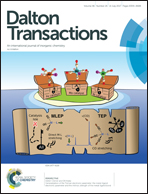Synthesis and photophysical and magnetic studies of ternary lanthanide(iii) complexes of naphthyl chromophore functionalized imidazo[4,5-f][1,10]phenanthroline and dibenzoylmethane†
Abstract
The luminescent ternary lanthanide(III) complexes [Ln(DBM)3(L1)] and [Ln(DBM)3(L2)] (Ln = Eu and Tb) of dibenzoylmethane (DBM) and 2-(2-naphthyl)-1H-imidazo[4,5-f][1,10]phenanthroline (L1) and 2-(2-hydroxy-1-naphthyl)-1H-imidazo[4,5-f][1,10]phenanthroline (L2) are reported in this work. The naphthyl chromophore functionalized imidazophenanthroline ligands L1 and L2 are structurally characterized by using single crystal X-ray diffraction: (L1), a = 14.933(4) Å, b = 7.4965(13) Å, c = 15.999(4) Å, α = γ = 90°, β = 102.670(7)°, V = 1747.4(6) Å3, Z = 4, monoclinic, P21/c and (L2), a = 7.8555(11) Å, b = 26.216(4) Å, c = 10.0748(17) Å, α = γ = 90°, β = 96.799(7)°, V = 2060.2(6) Å3, Z = 4, monoclinic, P21/n. A photophysical study reveals that the ligands L1 and L2 sensitize europium(III) emission. The complexes [Eu(DBM)3(L1)] and [Eu(DBM)3(L2)] exhibit the characteristic emission of the Eu(III) ion at 298 and 77 K. The terbium(III) complexes [Tb(DBM)3(L1)] and [Tb(DBM)3(L2)] exhibit only ligand centred fluorescence at room temperature, while metal centred emission is observed at 77 K. The non-luminescence of the Tb(III) center at room temperature is due to the proximity of the triplet states of the ligands to the 5D4 level of the Tb(III) ion. DC magnetic susceptibility studies have been conducted on the Tb(III) complexes in a 1 T field over the temperature range 20–300 K. The complexes display room temperature (300 K) χMT values of 9.69 and 10.21 cm3 mol−1 K, respectively. A gradual decrease in the χMT values is observed on reducing the temperature and reached the value of 7.80 and 6.60 cm3 mol−1 K, respectively, at 20 K. The decrease in the χMT values as the temperature is lowered could be attributed to the depopulation of the Zeeman split crystal field levels.
![Graphical abstract: Synthesis and photophysical and magnetic studies of ternary lanthanide(iii) complexes of naphthyl chromophore functionalized imidazo[4,5-f][1,10]phenanthroline and dibenzoylmethane](/en/Image/Get?imageInfo.ImageType=GA&imageInfo.ImageIdentifier.ManuscriptID=C7DT01133D&imageInfo.ImageIdentifier.Year=2017)


 Please wait while we load your content...
Please wait while we load your content...